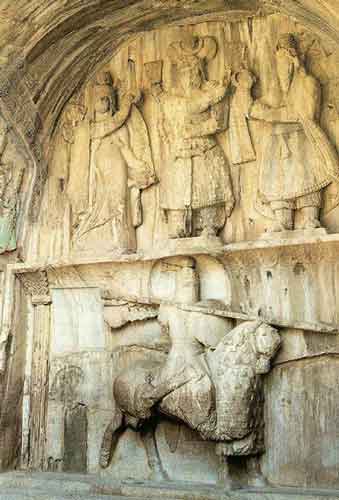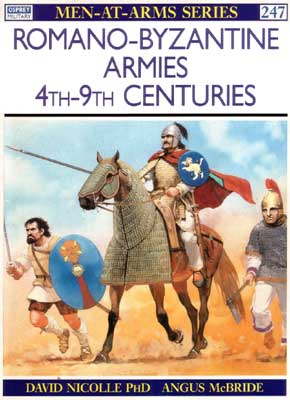.
The cataphract (Greek κατάφρακτος) was a type of heavy cavalryman used primarily in Iranian World from late antiquity up through the High Middle Ages. Iranians deploying cataphracts at some time in their history included the Sarmatians, Parthian dynasty, Sassanid Persians, Armenians, Pergamenes, and later Romans, Byzantines and others. The Romans and Byzantines adopted this type of unit from Iranians, especially from Parthians, after the Battle of Carrhae.
Cataphracts were the heavy assault force of most nations that used them, acting as shock troops supported by light or heavy infantry and foot or mounted archers. Supporting archery was deemed particularly important for the proper deployment of cataphracts. The Parthian army that defeated the Romans at Carrhae in 53 BC operated primarily as a combined arms team of cataphracts and horse archers against the Roman heavy infantry.
A cataphract charge was generally more disciplined and less impetuous than the charges of the knights of Western Europe. It was very effective due to the discipline and the large numbers of troops deployed.
Etymology of the Term
The adjective is Greek, with a basic meaning of "mail-clad." The Greek word for mail was cataphractes, which literally means "closed from all sides". The term first appears substantively in Latin, in the writings of Sisennus: ...loricatos, quos cataphractos vocant..., "...the armored, whom they call cataphracts..."
Equipment and Tactics

The Persian Knight, Sassanid dynasty (226-637 A.D.), Kermanshah, Iran.
Equipment and tactics varied, but cataphracts generally wore heavy armor of scale armour, mail, lamellar armour, horn, or thick quilted cloth, carried a shield, sat on an armoured horse, and charged with lances (kontos) in a tight knee-to-knee formation.
Their flexible but strong scale armor (φαλιδωτός) was made from overlapping plates of bronze or iron sewn onto an undergarment of leather, both on rider and horse. A close-fitting helmet that covered the head and neck was worn, with only narrow slits for the eyes.
Most armies' cataphracts would be equipped with an additional side-arm such as a sword or mace, for use in the melee that followed the charge. Some wore armour that was primarily frontal rather than providing equal protection all around, and sometimes likewise for the horse armour. In some armies cataphracts were not equipped with shields, particularly if they had heavy body armour.
They were supported by a chain attached to the horse's neck, and at the end by a fastening attached to the horse's hind leg, so the full momentum of horse was behind the spear-thrust. One reason for this was the lack of stirrups; although the Roman saddle had four horns to secure the rider (Driel-Murray & Connolly), the impact of a lance might well unseat them.
Many cataphract types were equipped with bows in addition to their lances and heavy armour, to allow them to engage the enemy from afar before charging. Cataphract archery was sometimes used tactically in disciplined formations where half the cataphracts stood facing the enemy as an armoured fence while the other half looped through the line to shoot and then back behind it to reload, increasing their safety against return fire from the enemy. Cataphracts without bows are sometimes referred to simply as lancers.
Some later cataphract types were also equipped with heavy darts (marzobarbouloi) to be hurled at the enemy lines during a charge, to disorder the defensive formation immediately before the impact of the lances. With or without darts, a cataphract charge would usually be "shot in" by foot or horse archers to either side, or by additional cataphracts who would charge in turn after having shot in the first assault. Some armies formalized this tactic by deploying separate types of cataphract, a very heavily armored bowless lancer for the primary charge and more conventional lance-and-bow cataphracts for supporting units.

Related Types
The Romans used cataphracts only late in their history, and even then primarily in the East. The first unit appeared during the reign of emperor Hadrian (117-138 A.D.). In addition to ordinary cataphract types they sometimes fielded a very heavy type called a clibanarius (pl. clibanarii), named after an iron oven due to their enclosed metal armor. They also formed one exotic experimental unit of scythed chariots with cataphract lancers mounted on the chariot's horses.
Nations in the Middle East occasionally fielded cataphracts mounted on camels rather than on horses, with obvious benefits for use in arid regions, as well as the fact that the smell of the camels, if up wind, was a guaranteed way of panicking enemy cavalry units that they came into contact with. Balanced against this is the relatively greater vulnerability of camel mounted units to caltrops, due to their having soft padded soles to their feet rather than hooves.
The Seleucid Empire armored large war elephants in chainmail and a head guard, carrying two men, one to drive and one to use a bow, in combat as cataphract elephants. They had an understandable impact on infantry and calvary as they watched arrows, swords and pila simply bounce off them.
See also
References
- Driel-Murray, C. van; Connolly, P. (1991) The Roman cavalry saddle. Britannia 22, pp. 33-50
- Nikonorov, Valerii P. (1985a) The Parthian Cataphracts In Chetvertaia vsesoiuznaia shkola molodykh vostokovedov. T. I. Moscow. pp. 65-67.
- Smith, William et. al. (1890) A Dictionary of Greek and Roman Antiquities. 3rd edition. Article Cataphracti. The text of this book is now in the public domain.
Bibliography
- Nikonorov, Valerii P. (1985b) The Development of Horse Defensive Equipment in the Antique Epoch.In Kruglikova, I. T. (ed.), Zheleznyi vek Kavkaza, Srednei Azii i Sibiri. Kratkie soobshcheniia Instituta arkheologii Akademii nauk SSSR. 184. Moscow: Nauka, 1985, pp. 30-35.
- Nikonorov, Valerii P. (1998) Cataphracti, Catafractarii and Clibanarii: Another Look at the old problem of their Identifications. In Voennaia arkheologiia: Oruzhie i voennoe delo v istoricheskoi i sotsial.noi perspektive (Military Archaeology: Weaponry and Warfare in the Historical and Social Perspective). St. Petersburg:. pp. 131-138.
- Warry, John Gibson (1980) Warfare in the classical world: an illustrated encyclopedia of weapons, warriors, and warfare in the ancient civilisations of Greece and Rome. New York, St. Martin's Press.
Links
- Detail of Sarmatian armored horse from Trajan's column project
- Third century CE graffito of Parthian Cataphractus from Dura Europos
| Ancient Greece
Science, Technology , Medicine , Warfare, , Biographies , Life , Cities/Places/Maps , Arts , Literature , Philosophy ,Olympics, Mythology , History , Images Medieval Greece / Byzantine Empire Science, Technology, Arts, , Warfare , Literature, Biographies, Icons, History Modern Greece Cities, Islands, Regions, Fauna/Flora ,Biographies , History , Warfare, Science/Technology, Literature, Music , Arts , Film/Actors , Sport , Fashion --- |
Retrieved from "http://en.wikipedia.org"
All text is available under the terms of the GNU Free Documentation License

